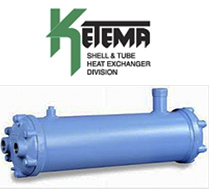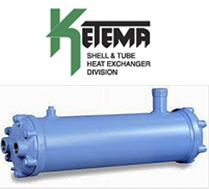 Shell and Tube Heat Exchangers & Unfired Boilers | Boilersupplies
Shell and Tube Heat Exchangers & Unfired Boilers | Boilersupplies
 Ketema & Whitlock Shell & Tube Heat Exchangers
Ketema & Whitlock Shell & Tube Heat Exchangers
Ketema and Whitlock Shell & Tube Heat Exchangers are designed for high efficiency and reliability in various industrial applications. These heat exchangers are constructed to meet stringent quality standards and deliver exceptional performance in heat transfer processes.
Key Features and Benefits:
Shell Assembly: Constructed from steel pipe or rolled plate metal for economic efficiency and durability. Shell roundness, achieved through mandrel expansion or double rolling, is critical for minimizing baffle spacing and optimizing performance. Impingement plates distribute fluid evenly to prevent erosion, vibration, and cavitation.
Tubes: Heat exchanger tubes, made from materials like low carbon steel, copper, stainless steel, and more, come in diameters of 0.625 to 1.5 inches. Tubes can be seamless or welded, with enhancements like fins to improve heat transfer rates. U-tube designs handle significant thermal differences but are harder to clean and maintain.
Bonnets and End Channels: Bonnets regulate fluid flow in the tube-side circuit and are fabricated or cast, mounted against the tube sheet with bolts and gaskets. They may include pass ribs for consistent fluid velocity and pressure drop. Materials used include iron, steel, bronze, Hastelloy, nickel-plated, or stainless steel.
Baffles: Baffles guide tubes during assembly, prevent vibration, and direct shell-side fluids to increase heat transfer. They must fit tightly within the shell to prevent fluid bypass and are precisely manufactured for easy assembly and maintenance. In liquid applications, baffles occupy 20-30% of the shell diameter; in gas applications, 40-45%. Even spacing reduces pressure drop and ensures fluid velocity.
Items to be returned must be approved by Power Plus International, and may be subjected to a restocking fee
Notice: Due to the uncontrollable metal costs, all prices and delivery times are subject to change on a daily basis.
PPI™ and Power Plus International™, and related marks and logos displayed on the Site, are our trademarks and may not be used in any way without our prior express written permission. Nothing contained on the Site shall be construed as granting, by implication, estoppel or otherwise, any license or right to use any of our marks displayed on the Site without our prior express written permission. All other trademarks not owned by us that appear on this Site are the property of their respective owners.
*NOTE: The products described herein are not manufactured by Patterson-Kelley nor is Power Plus
International in any way associated or affiliated with "PK", Patterson-Kelley, or Harsco Corporation.
|
Contact Us Directly:
|
Mailing Address:
|
|
Contact Us Directly:
|
© 2026 Boiler Supplies. All Rights Reserved. |
Mailing Address:
|




